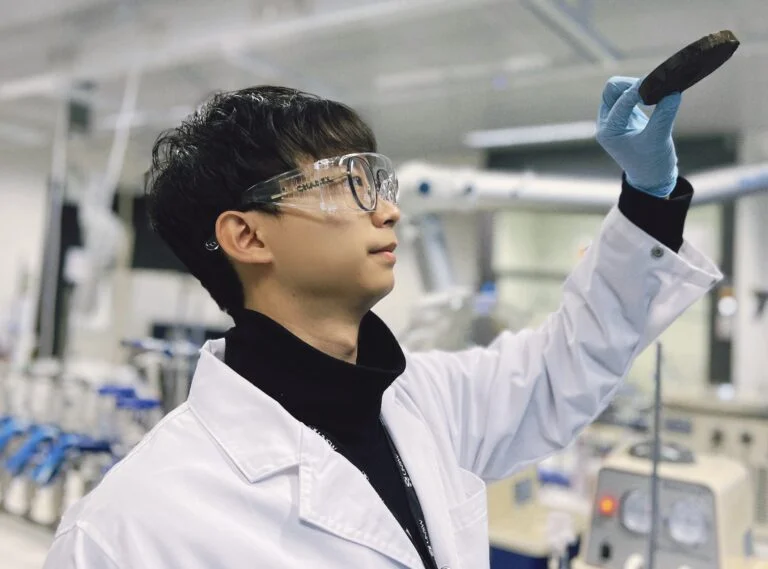An international scientific partnership has created a unique nanomaterial capable of efficiently harvesting clean drinking water from airborne water vapor. The study was published in the Proceedings of the National Academy of Sciences of the United States of America (PNAS).

The nanomaterial can store more than three times its weight in water and does so far faster than existing commercial methods, allowing it to be used directly to produce drinkable water from the air.
Professors Rakesh Joshi of the Australian Research Council Centre of Excellence for Carbon Science and Innovation (ARC COE-CSI) and Nobel Laureate Professor Sir Kostya Novoselov lead the partnership. Professor Joshi works at the University of New South Wales’ (UNSW) School of Materials Science and Engineering. Prof Novoselov is based at the National University of Singapore.
According to a United Nations report, around 2.2 billion people lack access to safe drinking water.
On Earth, approximately 13 million gigalitres of water are suspended in the atmosphere (500 gigalitres in Sydney Harbour). While this represents only a fraction of the total water on Earth, it is nonetheless a significant supply of fresh water.
Our technology will have application in any region where we have sufficient humidity but limited access to or availability of clean potable water.
Rakesh Joshi, Associate Professor, Australian Research Council Centre of Excellence for Carbon Science and Innovation
Prof Novoselov added, “This is an excellent example of how interdisciplinary, global collaboration can lead to practical solutions to one of the world’s most pressing problems—access to clean water.”
Finding Magic in the Bonding
The innovative nanomaterial is based on graphene oxide, a well-studied carbon lattice that is one atom thick and functionalized with oxygen-containing groups. Graphene oxide has strong water adsorption characteristics, which allow water to attach to the surface of a material.
Calcium has high water-adsorption qualities. The researchers decided to investigate the effects of intercalating or inserting calcium ions (Ca2+) into graphene oxide.
What transpired was unexpected.
Strong hydrogen bonds between the water and the material it adsorbs onto are crucial features of materials that successfully adsorb water, and graphene oxide and calcium both have this property. The stronger the hydrogen bond, the greater a material’s ability to adsorb water.
Calcium and oxygen have a synergistic effect that allows for remarkable water adsorption.
The researchers observed that the way calcium coordinates with oxygen in graphene modifies the strength of the hydrogen bonds between water and calcium, making those bonds stronger.
We measured the amount of water adsorbed onto graphene oxide by itself and we measured X. We measured the amount of water adsorbed onto calcium itself and we got Y. When we measured the amount of water adsorbed onto the calcium-intercalated graphene oxide we got much more than X+Y. Or it is like 1+1 equals a number larger than 2.
Xiaojun (Carlos) Ren, Study First Author and Research Assistant, University of New South Wales
“This stronger than expected hydrogen bonding is one of the reasons for the material’s extreme ability to adsorb water,” he added.
It is Also as Light as a Feather
The scientists added one more design adjustment to improve the material’s water adsorption ability: they created the calcium-intercalated graphene oxide in the shape of an aerogel, one of the lightest solid materials known.
Aerogels have a large surface area due to their many micro- to nanometer-sized pores, which enables them to develop and absorb water much more quickly than graphene oxide.
The aerogel offers sponge-like qualities that facilitate the desorption process, which releases water from the membrane.
The only energy this system requires is the small amount needed to heat the system to about 50 degrees to release the water from the aerogel.
Daria Andreeva, Study Co-Author and Principal Investigator, Institute for Functional Intelligent Materials, National University of Singapore
The Power of the Supercomputer
The study is based on theoretical and experimental research that used the Canberra-based Australian National Computational Infrastructure (NCI) supercomputer.
Professor Amir Karton of the University of New England led the computational study that provided the essential comprehension of the underlying process.
“The modelled simulations done on the supercomputer explained the complex synergistic interactions at the molecular level, and these insights now help to design even better systems for atmospheric water generation, offering a sustainable solution to the growing challenge of fresh water availability in regional Australia and in water-stressed regions across the globe,” added Prof Karton.
The Power of Science without Borders
This remains a basic scientific discovery that requires further development. Industry has worked together on this initiative to assist in the scale of this technology and create a prototype for testing.
“What we have done is uncover the fundamental science behind the moisture adsorption process and the role of hydrogen bonding. This knowledge will help provide clean drinking water to a large proportion of those 2.2 billion people that lack access to it, demonstrating the societal impact by collaborative research from our Centre,” stated COE-CSI Director and one of the co-authors on the study, Prof Liming Dai.
The study is a global partnership comprising research organizations in Australia, China, Japan, Singapore, and India.
Journal Reference:
Ren, X. et al. (2025) Synergetic hydrogen-bond network of functionalized graphene and cations for enhanced atmospheric water capture. Proceedings of the National Academy of Sciences of the United States of America. doi.org/10.1073/pnas.2508208122.

